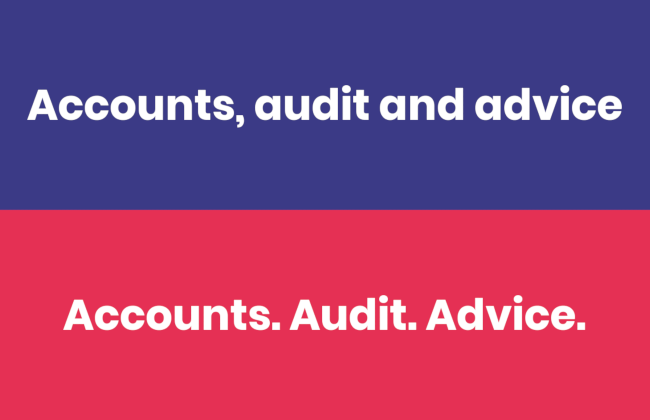Summary
Received wisdom among commercial writers used to be that using full stops in headings was a mistake. In recent years, though, that rule has been ignored frequently, with full stops used in copy to create a sense of confident finality.
Find out more about PracticeWeb’s copywriting service.
Editors tend to obsess over details and lately I’ve been thinking about full stops and the ways we at PracticeWeb use them in our copywriting for accountants.
Received wisdom among commercial writers used to be that using full stops in headings was a mistake because it brought the reader to a halt. You want them to read on, engage, get in touch – not hit a brick wall.
In recent years, though, that rule has been ignored frequently and now crops up often, giving headers, slogans and taglines a confident finality.
Look through the archive of ‘websites of the day’ at Awwwards and you’ll see that lots of recent examples use full stops in headings.
Sometimes it’s because the header amounts to a full sentence: ‘Every creative voice deserves to be heard.’ In other instances, it’s about adding a touch of quiet flair to minimalist copy: ‘New way of living.’ (You might also notice, by the way, that Awwwards uses a full stop in its own logo – even more unusual than using one in a heading.)
And Apple – a moderately successful business, I gather – often uses full stops in its online headers. (Microsoft doesn’t.)
Brands such as Airbnb, Nike and McDonald’s, all of which are perceived as ‘cool’, are keen on full stops, too:
- Book unique places to stay and things to do.
- Just do it.
- Luxury. In a bun.
What’s particularly fascinating about this trend is that outside the world of copywriting the full stop is experiencing a tough time altogether with talk of its impending extinction.
In 2016, psychologists at Binghamton University in New York asked students to rate the sincerity of a set of text messages. Those which ended with a full stop were interpreted as abrupt and insincere.
Anecdotal evidence since suggests that many younger people read a full stop at the end of a message as a sign that the sender is angry.
What that means, though, is that the most functional of punctuation marks – one most of us barely noticed – has gained new weight and power.
Perhaps we can think of it as a shift: the full stop is taking the place of the exclamation mark in indicating strong feelings, while the exclamation mark is morphing into the international symbol of ‘wackiness’.
(Aside: when I’m putting together tone of voice guidance for our clients I generally tell them to avoid exclamation marks.)
Sometimes, though, full stops are replacing commas. If a comma represents a ‘beat’ then the full stop can be a more definite version of the same.
Here’s an example:
Which of those will work best for you depends on your target audience, your brand and your firm’s tone of voice. The former reads as calmer, softer and more sophisticated; the latter as more confident, perhaps even blunt.
In his 1967 visual essay The Medium is the Massage philosopher Marshall McLuhan writes about the power of punctuation marks to visualise sound:
Reminders – (relics of the past) – in a world of the PRINTED word – efforts to introduce an AUDITORY dimension onto the visual organization of the page: all effect information, RHYTHM, inflection, pauses. Until recent years, these EFFECTS were quite elaborate – they allowed for all sorts of CHANGES of type faces. The NEWSPAPER layout provides more variety of AUDITORY effects from typography than the ordinary book page does.
Punctuation in practice
In recent months PracticeWeb has been working with Rise, a firm with a bold, disruptive voice. In this case, full stops work brilliantly adding an almost audible THUMP to the end of certain slogans and taglines, such as ‘The audit industry is broken.’ (McLuhan’s AUDITORY dimension.)
The copy for Rise has, in general, been whittled down to the very bare minimum with no wasted words so the full stops are also doing proportionally more work.
This approach is matched in the typography – heavy sans-serif fonts, often in all capitals – and in the assertiveness of the brand colour palette.
Looking for content that
gets results?
Our results-focused content marketing is designed to cut through noise, nurture sales prospects and build your firm’s reputation.
By contrast, another client whose site launched recently, an accountancy firm based in Manchester, has no full stop in the main header but does have a comma.
Though my team tested every different way you can imagine, in the end, softer, less definite punctuation seemed to fit the brand best. It read to us as warm, sophisticated and ‘premium’.
A comma before ‘and’? Although many people have been taught that there’s a rule against doing this, there isn’t and, in this case, it adds a ‘beat’ – a sense of rhythm. But it’s not a choice we made casually.
And that’s the point, I suppose: crafting copy is an entirely different discipline from merely writing, in which every choice matters, and must be deliberate.
If you’ve got only got a small space to play with, you’d better make every word or mark count.
Here’s a rough rule of thumb: you, or whoever is doing your copywriting, should probably aim to spend as long on a five-word heading as on the entirety of a 500-word piece of page copy.
Get in touch to find out more about PracticeWeb’s copywriting service.


